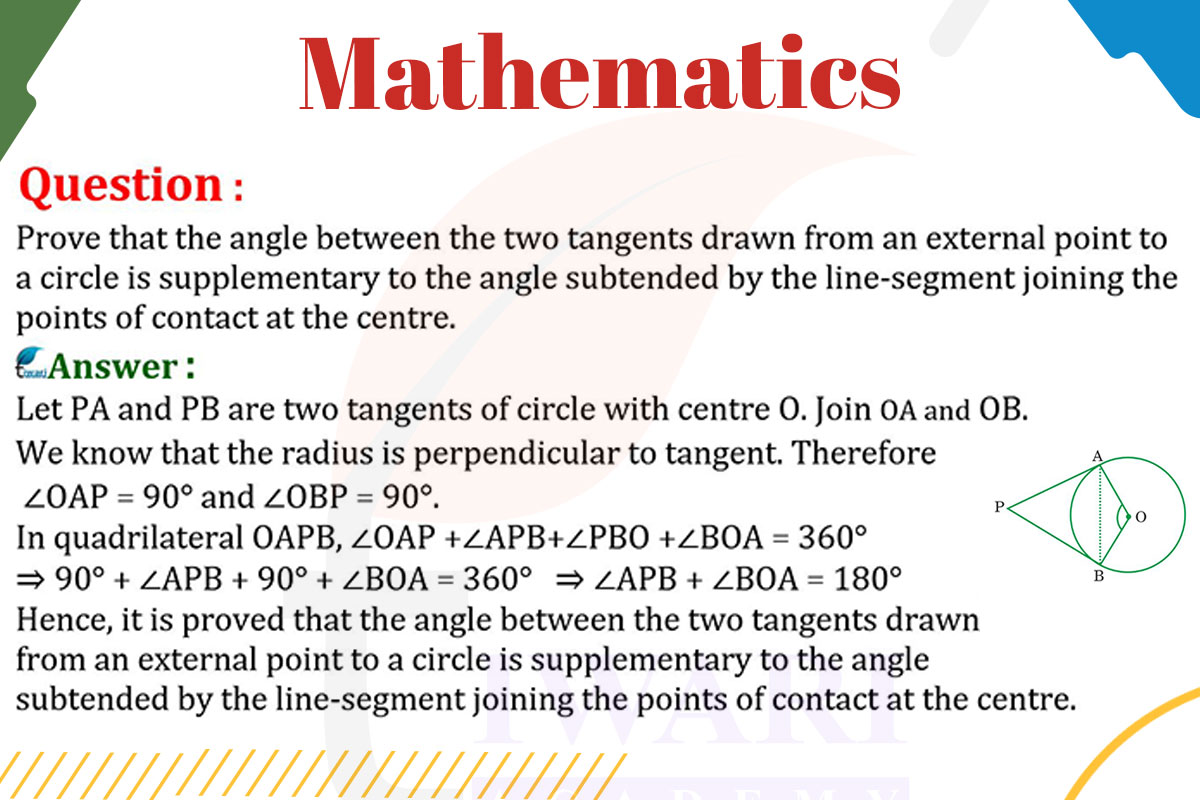To prove that the angle between two tangents drawn from an external point to a circle is supplementary to the angle subtended by the line segment joining the points of contact at the center:
Tangents and Radius: The radius of a circle is perpendicular to the tangent at the point of contact. Therefore, the radii drawn to the points of contact form right angles with the tangents.
External Angle of Triangle: The angle between the two tangents is the external angle of the triangle formed by the two radii and the line segment joining the points of contact.
External Angle Theorem: The external angle is equal to the sum of the opposite internal angles in a triangle.
Right Angles: Since the radii form right angles with the tangents, the two opposite internal angles are right angles (90° each).
Sum of Angles: The sum of the two right angles is 180°.
Conclusion: Therefore, the angle between the two tangents (external angle) is supplementary (180°) to the angle subtended by the line segment at the center.
Thus, the angle between two tangents drawn from an external point to a circle is supplementary to the angle subtended by the line segment joining the points of contact at the center.

Let’s discuss in detail
Tangents and Circle Geometry
In the study of circle geometry, one of the intriguing aspects is the relationship between tangents drawn from an external point and the angles these tangents form. A fascinating theorem in this context states that the angle between two tangents drawn from an external point to a circle is supplementary to the angle subtended by the line segment joining the points of contact at the center of the circle. This theorem not only enriches our understanding of circle geometry but also demonstrates the elegant interplay between tangents, angles, and radii.
Understanding Tangents from an External Point
A tangent to a circle is a line that touches the circle at exactly one point, known as the point of tangency. When two tangents are drawn from an external point to a circle, they touch the circle at two distinct points. These tangents, despite their individual straight paths, form an angle at the point from where they are drawn. This angle is crucial to our theorem and is the focus of our proof.
The Role of Radii to the Points of Tangency
In our scenario, when we draw radii from the center of the circle to the points of tangency, we create two right angles where the radii meet the tangents. This is because a radius of a circle is always perpendicular to the tangent at the point of tangency. These right angles are key to understanding the relationship between the angle formed by the tangents and the angle subtended at the center of the circle.
Triangle Formation and External Angle Theorem
The two radii and the line segment joining the points of tangency form a triangle within the circle. The angle between the two tangents, drawn from the external point, acts as an external angle to this triangle. According to the external angle theorem in geometry, an external angle of a triangle is equal to the sum of the two opposite internal angles.
Calculating the Supplementary Angles
In our triangle, the two internal angles are right angles (90° each) because they are formed by the radii perpendicular to the tangents. The sum of these right angles is 180°. Therefore, the external angle, which is the angle between the two tangents, is also 180°. This means that the angle between the tangents is supplementary to the angle subtended by the line segment at the center of the circle.
Supplementary Angles in Circle Geometry
Thus, we conclude that the angle between two tangents drawn from an external point to a circle is supplementary to the angle subtended by the line segment joining the points of contact at the center. This theorem elegantly illustrates the harmonious relationships in circle geometry, highlighting how tangents, radii, and angles cohesively interact to form consistent and predictable geometric patterns. It is a testament to the beauty and logical structure of mathematics in the realm of geometry.
Discuss this question in detail or visit to Class 10 Maths Chapter 10 for all questions.
Questions of 10th Maths Exercise 10.2 in Detail

